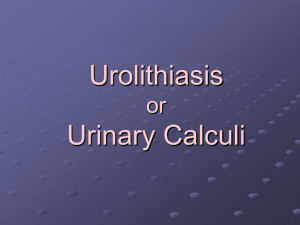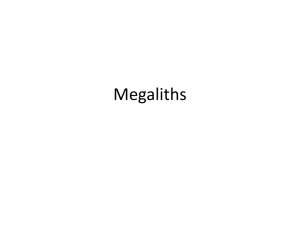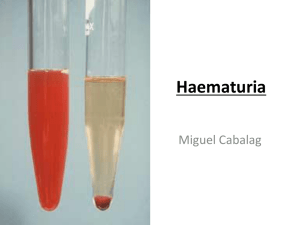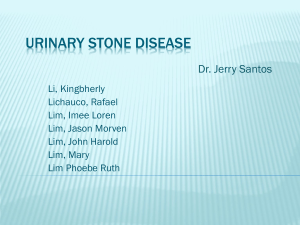Renal stone - Sehat Evam Surat
advertisement
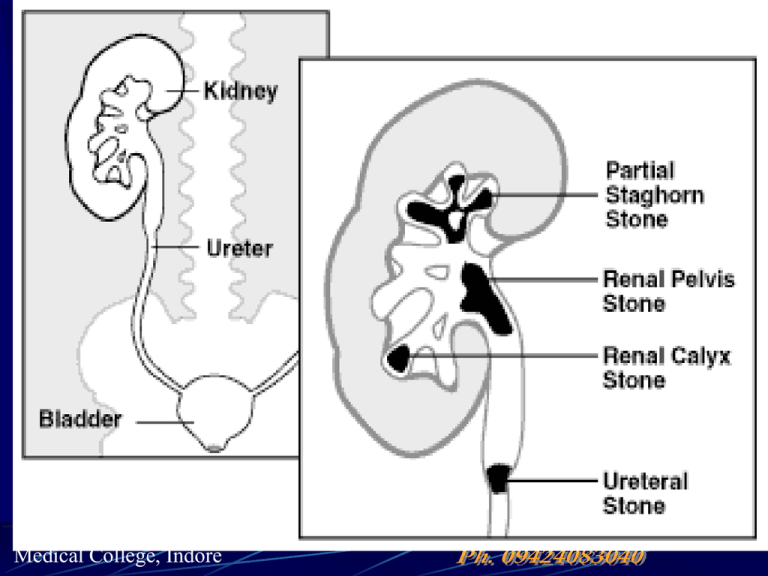
H.O D Department of Physiology SKRP Gujrati Homoeopathic Medical College, Indore DIRECTOR INDEX 1) INTRODUCTION 2) ETIOLOGY 3) TYPES OF RENAL CALCULI 4) EFFECTS OF STONES 5) CLINICAL FEATURES 6) SPECIAL INVESTIGATIONS 7) TREATMENT 8) GENERAL MEASURES NEPHROLITHIASIS Renal stone or calculus or Lithiasis is one of the most common diseases of the urinary tract. • Occurs more frequently in men than in women and in whites than in blacks. • Rare in children. It shows a familial predisposition. • World wide in distribution and common in U.S, SOUTH AFRICA, INDIA , SOUTH EAST ASIA Urinary calculus is a stone - like body composed of urinary salts bound together by a colloid matrix of organic materials. It consists of a nucleus around which concentric layers of urinary salts are deposited.. ETIOLOGY HYPEREXCRETION CONSTITUENTS – OF RELATIVELY INSOLUBLE URINARY 1. Oxalate – Though oxalate is the major component of 70% of all renal stones, yet hyperoxaluria as a cause of formation of such stone is relatively rare. Cabbage, rhubarb, spinach, tomatoes, black tea and cocoa contain large amount of oxalate. Ingestion of excessive amounts of ascorbic acid and orange juice also increase urinary oxalate excretion. 2. Calcium - On regular diets normal urinary excretion of calcium ranges between 200 mg to 300 mg per day. The major calcium in foods are in milk and cheese. Milk and dietary protein also cause increased absorption of calcium from the gut. 3. Uric acid - Many patients with gout form uric acid calculi particularly when under treatment. If the urine is made alkaline and dilute while treating this disease chance of uric acid stone formation is less 4. Cystine – Cystinuria is an herditary disease which is more common in infants and children. Only a small percentage of patients with Cystinuria form stones. 5. Drug induced stones – In rare cases, the long term use of magnesium trisilicate in the treatment of peptic ulcer has produced radio opaque silicon stones. B. PHYSICAL CHANGES IN THE URINE – 1. Urinary pH - The mean urinary pH is 5.85. It is influenced by diet and medicines. If the urine becomes infected with urea splitting bacteria e.g. calcium phosphate. 2. Colloid content - As mentioned above it has long been claimed that the colloids in the urine allow the crystalloids to be held in a supersatured state. 3. Decreased concentration of crystalloids - This may be due to low fluid intake, excessive water losses in febric disease and in hot climates, due to excessive perspiration or due to excessive water loss from vomiting and diarrhea. 4 Urinary magnesium calcium ratio - This probably has notable influence on stone formation Acetazolamide (Diamox) causes hypocalcaemia and a decrease in the ratio. G. URINARY STATIS It goes without saying that stones are more prone to occur when there is obstruction to the free passage of urine (a) Urinary stasis provides a fertile field for bacterial growth (b) It also cause a shift of the pH of the urine to the alkaline side (c) Stasis also predisposes urinary infection (d) It allows the crystalloids to precipitate. H. HYPERPARATHYROIDISM Though this condition is seen in only 2% to 5% of cases of renal stone, yet its potentiality to form urinary calculus cannot be underestimated. In cases of multiple or recurrent urinary calculi this cause should be eliminated. Due to overproduction of Parathhormone the bones become decalcified and calcium concentration in the urine in increased. This extra calcium may be deposited in the renal tubules or in the pelvic to form renal calculus LOCATION OF STONES IN KIDNEY Types of renal calculi Primary Stones Are those which appear in apparently healthy urinary tract without any antecedent inflammation. These stones are usually formed in acid urine. Usually consist of calcium oxalate uric acid, urates, Cystine, xanthine or calcium carbonate. Secondary Stones Are usually formed as the result of inflammation. The urine is usually alkaline as urea splitting organism are most often the causative organisms. Secondary stones are mostly composed of calcium Ammonium-magnesium phosphate (the so-called triple phosphates). PRIMARY STONES 1. Oxalate calculus (calcium oxalate) - This type of stone is usually single and it extremely hard. It is dark in color due to staining with altered blood precipitated on its surface. 2. Uric acid and urate calculi - Pure uric acid calculi are rate and are not visible in X-ray (not radio opaque). These stones usually occur in multiples and so are typically faceted. The stones are of moderate hardness. In children, stones of ammonium and sodium urate are sometimes found. These stoneware yellow, soft and friable. 3. Cystine calculi - These stones usually appear in patients with cystinuria Cystinuria sometimes occurs in young girls. Cystine is an aminoacid rich in sulphur. Cystine calculi usually occur in multiple are soft and yellow or pink in color. 4. Xanthine calculi - These are extremely rate smooth round and brick red in colour. 5. Indigo calculi - SECONDRY STONES 1. Phosphate calculus – Majority of these stones are composed of calcium phosphate, though few are composed of ammonium magnesium phosphate 'triple phosphate' smooth, soft and friable. It is usually dirty white in colour. This type of calculus usually occurs in infected urine. Urine is often alkaline. Such stone enlarges rapidly and gradually fills up pelvic. 2. Mixed Stones EFFECTS OF STONE The size and position of the stone usually govern the development of secondary pathologic changes in the urinary trace. A. SAME KIDNEY – 1. 2. Obstruction Infection B OPPOSITE KIDNEY 1. Compensatory hypertrophy 2. Stone formation may be bilateral 3. Infection 4. Calculus anuria . CLINICAL FEATURES Symptoms - Symptom wise cases can be divided into 4 groups :1. Quiescent calculus – A few stones, particularly the phosphate stones, may lie dormant for quite a long period. These stone are also discovered due to symptoms of Urinary Infection 2. Pain - Plain is the leading symptom of renal calculus in majority of cases (80%). Three types of pain . a) Fixed renal pain b) Ureteric colic c) Referred pain 3. Hydronephrosis 4. Occasionally haematuria is the leading and only symptom. PHYSICAL SIGNS In majority of cases characteristic physical signs are not present. The signs which may be present and should be looked for are : (i) Tenderness (ii) Muscle rigidity over the kidney may be found in a few cases. (iii) Swelling - When there is Hydronephrosis or pyonephrosis associated with renal calculus, a swelling may be felt in the flank. The characteristic of a renal swelling are :- (a) Oval or reniform in shape (b) Swelling is almost fixed and cannot be moved. (c) A kidney lump is ballot able. SPECIAL INVESTIGATIONS Blood examination – Hardly reveals any specific abnormality, increased white blood cell associated with infection. Anemia may be found, blood urea, creatinine. 2. Urinalysis (i) Physical examination Show smoky urine due to slight haematuria or pale scent due to presence of pus. (ii) Chemical examination Show presence of protein due to haematuria and blood in the urine. If pH of the urine is higher than 7.6, presence of urea-splitting organism is assured. (iii) Microscopic examination of urine Show R.B.C. pus cells and casts. Different crystals may be seen in the sediment to givea clue as to the type of stone present. Uric acid of glacial acetic acid, which lowers the urinary pH to about 4. (iv)Bacteriological examination of urine Highly important including culture and sensitivity tests. (v) Renal function tests Always be performed in calculus cases. The PSP may be normal even in presence of bilateral stag horn calculi. 1. 3.Radiography A) STRAIGHT X-RAY - Before taking straight X-ray for KUB region (both kidneys, ureters and bladder), the bowels must be made empty by giving laxative. B) Excretory Urogram 4 Ultrasonography – Helpful to distinguish between opaque and non-opaque stones. It is also of value in locating the stones for treatment with extra corporeal shock wave therapy. 5 Computed topography – Particularly helpful in the diagnosis of non-opaque stones. 6 Renal Scan 7 Instrumental examination :- Cystoscopy 8 Examination of the stone TREATMENT ESWL (Extra corporeal Shock Wave Lithotripsy) In this technique the stone is removed with shock wave without the need for instrumental penetration of the body. The stone in the kidney is fragmented by repeated shock waves which are focused towards the kidney stone. The fragments are made so small that they are automatically passed through the urine. In some instances a ureteroscope may be required for the passage of fragments. This method is gradually replacing operative methods of removal of renal calculi. Nephrectomy Ureteroscopy (URS) Open Surgery Pyelolithotomy Nephrolithotomy Partial nephrectomy HOMOEOPATHIC REMEDIES FOR *NEPHROLITHIASIS * I. B E R B E R I S VULGARIS Pain in small of back; very sensitive to touch in renal region; < when sitting and lying, from jar, from fatigue. Burning and soreness in region of kidneys Numbness, stiffness, lameness with painful pressure in renal and lumbar regions. Pale, earthy complexion, with sunken cheeks and hollow, blue-encircled eyes. Stitching, cutting pain from left kidney following course of ureter into bladder and urethra ,Renal colic, < left side Urine : greenish, blood-red, with thick, slimy mucus; transparent, reddish or jelly-like sediment. Movement brings on or increase urinary complaints. Aggravation - Motion, walking or carriage-riding; any sudden jarring movement. Solitude is unbearable : desires company. Anguish : he sits, then walks, then lies, never long in one place II. L Y C O P O D I U M CLAVATUM Red sand in urine, on child's diaper Child cries before urinating Pain in back, Relieved by urinating; Right sided renal colic III. M E D O R R H I N U M Severe pain (backache) in renal region, > by profuse, urination Renal colic; intense pain in ureters, with sensation of passing of calculus IV. S A R S A P A R I L L A Severe, almost unbearable pain at conclusion of urination Passage of gravel or small calculi; renal colic; Stone in bladder; Bloody urine. Urine : bright and clear but irritating; scanty, slimy, flaky, sandy, copious, passed without sensation deposits white sand. General measures The general measures or advises which should be given to the patient regardless of the type of stone are (a) Fluid intake should be high at all times. Fluids should be taken at bed time so that nocturia will occur. This will prevent dehydration. (b) Avoidance of milk, cheese and great deal of calcium should be advised. If renal function is satisfactory sodium cellulose phosphate 5g. T.D.S. with meals should be prescribed to reduce calcium absorption. (c) Urine should be kept acid all the time. Alkalies should be prohibited or used in less quantities in those patients who are suffering from peptic ulcer. (d) Vitamin D should be stopped or used in very low quantity . CONSERVATIVE MEASURES Not all patients with renal stones require surgery. (i) When the stones are sufficiently small, these can be naturally eliminated and expectant policy is best adopted in these cases. (ii) In the elderly, poor risk patients a curalliform stone is best left alone unless it causes significant symptoms. (iii) Chemical dissolution of renal stones requires indwelling urethral catheters for constant through and through irrigation with Renacidin or with G solution. Sometimes stone fragments occlude the ureteral catheters and cause acute obstruction. With the advent of percutneous Extra corporeal shock wave Lithotripsy (ESWL), this method has mostly become obsolete. Prevention As the patients who have already undergone treatment for renal stones should be managed prophylactic ally in an attempt to prevent recurrence. With more knowledge of stone formation, responsibilities lie on the surgeons to prevents further stone formation and cannot be left solely to God to prevent recurrence or to fully cure the patient. A. False recurrence, which means a tiny stone was overlooked at the time of operation, B. True recurrence - A patient with renal stone is usually liable to produce further stone subsequently. So attempt should always be made to prevent such recurrence THANKS
